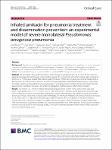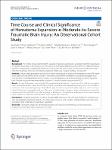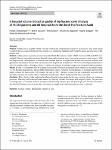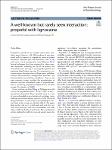Search
Author
- Daqing, Ma (3)
- Alexis, Ferré (2)
- Anna, Lybeck (2)
- Ashish K., Khanna (2)
- next >
Subject
- intensive care unit (8)
- acute respiratory dist... (5)
- chronic obstructive pu... (5)
- ICU (5)
- next >
Date issued
Has File(s)
Search Results
A tracheal foreign body is a common airway aspiration that creates an emergency, which often causes unobserved respiratory problems and requires management. Iatrogenic tracheal foreign bodies are rarely observed, which results in tracheal obstruction. If the foreign body were removed from the tracheobronchial system, it would save lives. A similar case of a tracheal foreign body was focused on, which was caused by medical glue used during preoperative computed tomography localization of pulmonary nodules. |
To investigate vascular endothelial dysfunction based on glycocalyx impairment in massive hemorrhage and to evaluate fluid therapy. |
Pseudomonas aeruginosa pneumonia is commonly treated with systemic antibiotics to ensure adequate treatment of multidrug resistant (MDR) bacteria. However, intravenous (IV) antibiotics often achieve suboptimal pulmonary concentrations. We therefore aimed to evaluate the effect of inhaled amikacin (AMK) plus IV meropenem (MEM) on bactericidal efficacy in a swine model of monolateral MDR P. aeruginosa pneumonia. |
Despite improvements in the critical care management of subarachnoid hemorrhage (SAH), a substantial number of patients still suffer from disabilities. In most areas of the world, longitudinal follow-up is not routinely performed, and the patient’s trajectory remains unknown. |
Preventing intracranial hematoma expansion has been advertised as a possible treatment opportunity in traumatic brain injury (TBI). However, the time course of hematoma expansion, and whether the expansion affects outcome, remains poorly understood. In light of this, the aim of this study was to use 3D volume rendering to determine how traumatic intracranial hematomas expand over time and evaluate its impact on outcome. |
To observe if blood return, also defined as the blood infusion test (BIT) could predict fluid responsiveness in critically ill patients with acute circulatory failure and renal replacement therapy (RRT). |
The importance of treating severely injured patients in higher-level trauma centers is undisputable. However, it is uncertain whether severely injured patients that were initially transported to a lower-level trauma center (i.e., undertriage) benefit from being transferred to a higher-level trauma center. |
Evidence for a hospital volume–outcome relationship in hip fracture surgery is inconclusive. This study aimed to analyze the association between hospital volume as a continuous parameter and several processes and outcomes of hip fracture care. |
Propofol is considered an excellent intravenous anesthetic agent. However, a 30–70% incidence of pain associated with its injection is a significant source of patient discontent. Injection pain and discomfort rank as the sixth most crucial perioperative issue (Desousa 2016). Several techniques have been employed to reduce injection discomfort, including the use of the forearm and antecubital veins, freezing or warming the injectate, and aspirating blood before injection. Pre-treatment or contemporaneous administration of thiopentone, pethidine, fentanyl, dexamethasone, nitroglycerine, ketorolac, and local anesthetics has also been considered. |
Damage control orthopaedics (DCO) und early total care (ETC) are well-established strategies for managing severely injured patients. There is no definitive evidence of the superiority of DCO over ETC in polytrauma patients. We conducted this study to assess the probability of a polytraumatised patient undergoing DCO. In addition, the effect of DCO on complications and mortality was investigated. |










